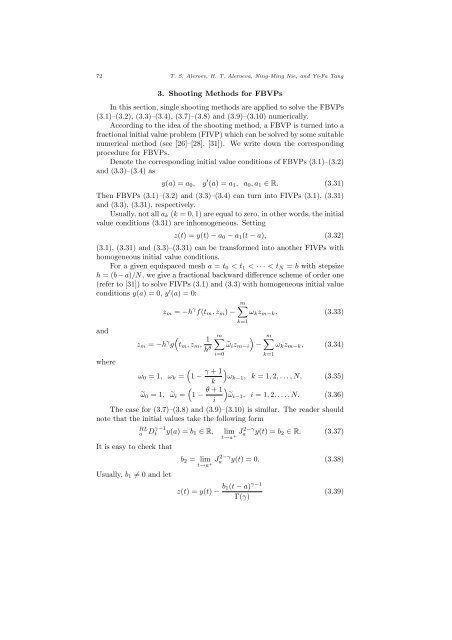FOR DIFFERENTIAL EQUATIONS OF FRACTIONAL ORDER
FOR DIFFERENTIAL EQUATIONS OF FRACTIONAL ORDER
FOR DIFFERENTIAL EQUATIONS OF FRACTIONAL ORDER
You also want an ePaper? Increase the reach of your titles
YUMPU automatically turns print PDFs into web optimized ePapers that Google loves.
72 T. S. Aleroev, H. T. Aleroeva, Ning-Ming Nie, and Yi-Fa Tang3. Shooting Methods for FBVPsIn this section, single shooting methods are applied to solve the FBVPs(3.1)–(3.2), (3.3)–(3.4), (3.7)–(3.8) and (3.9)–(3.10) numerically.According to the idea of the shooting method, a FBVP is turned into afractional initial value problem (FIVP) which can be solved by some suitablenumerical method (see [26]–[28], [31]). We write down the correspondingprocedure for FBVPs.Denote the corresponding initial value conditions of FBVPs (3.1)–(3.2)and (3.3)–(3.4) asy(a) = a 0 , y ′ (a) = a 1 , a 0 , a 1 ∈ R. (3.31)Then FBVPs (3.1)–(3.2) and (3.3)–(3.4) can turn into FIVPs (3.1), (3.31)and (3.3), (3.31), respectively.Usually, not all a k (k = 0, 1) are equal to zero, in other words, the initialvalue conditions (3.31) are inhomogeneous. Settingz(t) = y(t) − a 0 − a 1 (t − a), (3.32)(3.1), (3.31) and (3.3)–(3.31) can be transformed into another FIVPs withhomogeneous initial value conditions.For a given equispaced mesh a = t 0 < t 1 < · · · < t N = b with stepsizeh = (b − a)/N, we give a fractional backward difference scheme of order one(refer to [31]) to solve FIVPs (3.1) and (3.3) with homogeneous initial valueconditions y(a) = 0, y ′ (a) = 0:m∑z m = −h γ f(t m , z m ) − ω k z m−k , (3.33)andi=0k=1z m = −h γ g(t m , z m , 1 ∑m ) m∑h θ ˜ω i z m−i − ω k z m−k , (3.34)where(ω 0 = 1, ω k = 1 − γ + 1 )ω k−1 , k = 1, 2, . . . , N, (3.35)k(˜ω 0 = 1, ˜ω i = 1 − θ + 1 )˜ω i−1 , i = 1, 2, . . . , N. (3.36)iThe case for (3.7)–(3.8) and (3.9)–(3.10) is similar. The reader shouldnote that the initial values take the following formRLa D γ−1t y(a) = b 1 ∈ R, lim t→a + a y(t) = b 2 ∈ R. (3.37)It is easy to check thatUsually, b 1 ≠ 0 and letk=1b 2 = limt→a + J 2−γa y(t) = 0. (3.38)z(t) = y(t) − b 1(t − a) γ−1Γ(γ)(3.39)
















